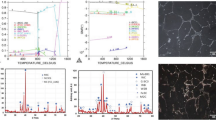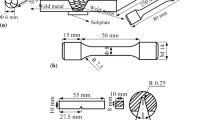Abstract
Special wear-resistant steels are essential in applications with extreme abrasion conditions. Main applications of low-alloyed, weldable abrasion-resistant steels are found in mining, agriculture, and elsewhere. They are normally produced via continuous casting process and then hot rolled into heavy plates of desired thickness and width. This paper focuses on the strand casting part where the solidification interval of boron 500HB steel is studied through DTA heating curves and compared with thermodynamic predictions using Thermo-Calc (TCFE7 and TCFE9 database) and JMatPro with internal database General steel. Liquidus temperatures measured from the second heating curve are in good agreement with the thermodynamic approach using both commercial software. Additionally, the invariant peritectic temperature was experimentally determined and a reasonable agreement is achieved with predictions. All databases revealed a similar solidus temperature if the calculation was performed without boron included. By including 23 ppm of boron into the calculation, only one commercial software predicted the solidus temperature in good agreement with the measured value determined by DTA, the other result differed significantly. This study shows that important variation of the predicted metallurgical length in the strand slab caster exists if the solidus position is estimated using thermodynamic prediction. As the studied samples were taken directly from an industrial plate, a qualitative evaluation of micro-segregation through the cross-section of the thickness was also done and taken into account with thermal analysis.









Similar content being viewed by others
References
Ulewicz R, Szataniak P, Novy F. Fatigue properties of wear resistant martensitic steels. In: MeTal 2014. Proceedings of the MeTal conference; 2014 May 21–23; Brno, Czech Republic. http://metal2014.tanger.cz/files/proceedings/17/reports/2599.pdf . Accessed 22 Apr 2018.
Jokiaho T, Laitinen A, Santa-aho S, Isakov M, Peura P, Saarinen T, Lehtovaara A, Vippola M. Characterization of flame cut heavy steel: Modeling of temperature history and residual stress formation. Metall and Materi Trans B. 2017;48:2891–901. https://doi.org/10.1007/s11663-017-1090-x.
Ahlblom B, Hansson P, Narström T. Martensitic Structural Steels for Increased Strength and Wear Resistance. Mater Sci Forum. 2007;539–543:4515–20. https://doi.org/10.4028/www.scientific.net/msf.539-543.4515.
SIJ Acroni d.o.o.. SIJ Acroni [Internet]. 2014 [cited 2020 Apr 21]. Available from: https://sij.acroni.si/sl/
SSAB [Internet]. 2020 [cited 2020 Apr 21]. Available from: https://www.ssab.com
Thyssenkrupp AG. Thyssenkrupp steel Europe [Internet]. 2019 [cited 2020 Apr 21]. Available from: https://www.thyssenkrupp-steel.com
Ojala N, Valtonen K, Heino V, Kallio M, Aaltonen J, Siitonen P, Kuokkala VT. Effects of composition and microstructure on the abrasive wear performance of quenched wear resistant steels. Wear. 2014;317:225–32. https://doi.org/10.1016/j.wear.2014.06.003.
Wojciech Ozgowicz S, Opiela M, Grajcar A, Kalinowska-Ozgowicz E, Krukiewicz W. Metallurgical products of microalloy constructional steels. J Achiev Mater Manuf Eng. 2011;44:7–34.
Yuga M, Miura S, Ohmori A. Wear-resistant steel plate and process for producing same. 3 098 331 B1. JP. 2016.
Baker TN. Microalloyed steels. Ironmak Steelmak. 2016;43(4):264–307. https://doi.org/10.1179/1743281215Y.0000000063.
Gladman T. The physical metallurgy of microalloyed steels. 1st ed. Cambridge: The Institute of Materials, University of Leeds; 1997.
SMS Demag AG. Classification of defects in materials-Standard charts and sample guide. SN960. DE. 2009.
Zhang A, Wang G, Jiao S. Ultrahigh-strength wear-resistant steel plate and method of manufacturing the same. 9,695,487 B2. CN. 2017.
Jiang L, Humphreys AO, Jonas JJ. Effect of silicon on the interaction between recrystallization and precipitation niobium microalloyed steels. ISIJ Int. 2004;44(2):381–7.
European standards. Hot rolled products of structural steels-Part 5: Technical delivery conditions for structural steels with improved atmospheric corrosion resistance; EN 10025–5:2005.
François H, Bonnevie M. From monometallic to composites and ceramic wear resistant materials: an industrial challenge. In: Proceedings of the International Symposium on Wear Resistant Alloys for the Mining and Processing Industry; 2015 May 4–7; São Paolo, Brazil. CBMM; 2018. p. 19–45. https://www.niobelcon.com/NiobelCon/resources/Volume-3.pdf . Accessed 22 Apr 2020.
Bernetič J, Bradaškja B, Kosec G, Kosec B, Bricelj E. Centreline formation of the Nb(C,N) eutectic in 0.15 % C, 0.0071 % N, 0.022 % Nb, 0.033 % Al and 0.003 % S structural steel. Mater Technol. 2008;42:6,291–294.
Yang S, Gao Y, Xue X, Li B. Influence of titanium on transformation behaviour during continuous cooling of boron microalloyed steels. Ironmak Steelmak. 2018;45(10):959–68.
Hannula J, Kömi J, Porter DA, Somani MC, Kaijalainen A, Suikkanen P, et al. Effect of boron on the strength and toughness of direct-quenched low-carbon niobium bearing ultra-high-strength martensitic steel. Metall Mater Trans A. 2017;48A:5344–56.
Stalheim DG, Peimao F, Linhao G, Yongqing Z. Metallurgical/Alloy optimization of high strength and wear resistant structural quench and tempered steels. In: TMS, editor(s). HSLA Steels 2015, Microalloying 2015 & Offshore Engineering Steels 2015: Conference Proceedings. The Minerals, Metals & Materials Society, 2016; p. 995–1001. https://doi.org/https://doi.org/10.1002/9781119223399.ch125
Stalheim D. Metallurgical strategy for optimized production of QT high-strength and abrasion-resistant plate steels. In: AISTech 2019. 2019 AISTech Conference Proceedings; 2019 May 6–8; Pittsburgh, USA. AIST; 2019. p. 1881–1892. http://dx.doi.org/https://doi.org/10.33313/377/192
Ishikawa K, Nakamura H, Homma R, Fujioka M, Hoshino M. Effect of molybdenum content on the combined effect of boron and molybdenum on hardenability of low-carbon boron-added steels. ISIJ Int. 2018;58(3):551–60.
Leslie WC. The physical metallurgy of steels. 1st ed. Tokyo: McGraw-Hill; 1982.
Hakan Atapek Ş, Erişir E, Gümüş S. Modeling and thermal analysis of solidification in a low alloy steel. J Therm Anal Calorim. 2013;114:179–83. https://doi.org/10.1007/s10973-012-2930-1.
Wielgosz E, Kargul T. Differential scanning calorimetry study of peritectic steel grades. J Therm Anal Calorim. 2015;119:1547–53. https://doi.org/10.1007/s10973-014-4302-5.
Karagöz Ş, Atapek S, Yilmaz A. Microstructural and Fractographical Studies on Quenched and Tempered Armor Steels. Mater Test. 2010;52:316–22. https://doi.org/10.3139/120.110134.
Kalup A, Smetana B, Kawuloková M. et al. Liquidus and solidus temperatures and latent heats of melting of steels. J Therm Anal Calorim. 127, 123–128 (2017). https://doi.org/10.1007/s10973-016-5942-4
Luitjohan K. Boron segregation and its effects in advanced high strength steel. Purdue University; 2018.
Sun J, Zhu H, Wang W, Duan Y. Effect of boron segregation on the surface crack of low carbon boron-bearing steel. Results Phys. 2019;13:102153. https://doi.org/10.1016/j.rinp.2019.02.089.
Miettinen J, Vassilev G. Thermodynamic description of ternary Fe-B-X Systems. Part 1: Fe-B-Cr. Arch Metall Mater. 2014;59. Doi: https://doi.org/10.2478/amm-2014-0099.
Blazek K-E, Lanzi O, Yin H. Boron effects on the solidification of steel during continuous casting. Rev Met Paris. 2009;105:609–25. https://doi.org/10.1051/metal:2009005.
Campbell J. The consolidation of metals: the origin of bifilms. J Mater Sci. 2016;51:96–106. https://doi.org/10.1007/s10853-015-9399-9.
Bradaskja B, Fazarinc M., Klancnik G. Method and device for determining characteristic temperatures of steel taken directly from a tundish. WO2016108762A1. SLO. 2016. https://patentimages.storage.googleapis.com/a9/03/28/8cdd01f811d2d0/WO2016108762A1.pdf Accessed 23 Apr 2020
Boettinger JW, Kattner UR. On DTA curves for the melting and freezing of alloys. Metall Mater Trans A. 2002;33A:1779–94.
Klančnik U, Habjan J, Klančnik G, Medved J. Thermal analysis of indefinite chill cast iron modified with ferrovanadium and ferrotungsten. J Therm Anal Calorim. 2017;127:71–8. https://doi.org/10.1007/s10973-016-5434-6.
ISO Standards. Metallic Materials, Conversion of hardness values; ISO 18265.
Grye K, Smetana B, Žaludová M, Michalek K, Klus P, Tkadlečková M, et al. Determination of the solidus and liquidus temperatures of the real-system grades with dynamic thermal-analysis methods. Mater Technol. 2013;47(5):569–75.
Presoly P, Pierer R, Bernhard C. Identification of defect prone peritectic steel grades by analyzing high-temperature phase transformations. Metall and Mat Trans A. 2013;44A:5377–88. https://doi.org/10.1007/s11661-013-1671-5.
Durand-Charre M. Microstructure of Steels and Cast Irons. Berlin: Springer-Verlag; 2003.
Lage MG, Silva ALV. Evaluating segregation in HSLA steels using computational thermodynamics. J mater res technol. 2015;4(4):353–8. https://doi.org/10.1016/j.jmrt.2015.06.002.
Dhindaw BK, Antonsson T, Fredriksson H, et al. Characterization of the peritectic reaction in medium-alloy steel through microsegregation and heat-of-transformation studies. Metall Mater Trans A. 2004;35:2869–79. https://doi.org/10.1007/s11661-004-0235-0.
Banaschik R, Brätz O, Henkel K-M. Systematic expansion of the microstructural characterization of ferritic weld. Prakt Metallogr-PR M. 2017;54:669–83.
Samuels LE. Light microscopy of carbon steels. 2nd ed. Ohio: ASM International; 2003.
ASTM E45–18a, Standard Test Methods for Determining the Inclusion Content of Steel, ASTM International, West Conshohocken, PA, 2018. Doi: https://doi.org/10.1520/E0045-18A.
Acknowledgements
This research was made as a part of the ČMRLJ research project co-financed by the Republic of Slovenia and the European Union under the European Regional Development Fund.
Author information
Authors and Affiliations
Corresponding author
Additional information
Publisher's Note
Springer Nature remains neutral with regard to jurisdictional claims in published maps and institutional affiliations.
Rights and permissions
About this article
Cite this article
Klančnik, G., Foder, J., Jan, P. et al. DTA study and thermodynamic prediction of the solidification interval of boron 500HB abrasion-resistant steel. J Therm Anal Calorim 147, 1999–2011 (2022). https://doi.org/10.1007/s10973-021-10628-2
Received:
Accepted:
Published:
Issue Date:
DOI: https://doi.org/10.1007/s10973-021-10628-2




